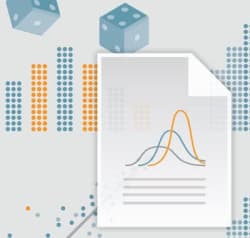Images
In business, data and algorithms create economic value when they reduce uncertainty about financially important outcomes. This course teaches the concepts and mathematical methods behind the most powerful and universal metrics used by Data Scientists to evaluate the uncertainty-reduction – or information gain – predictive models provide. We focus on the two most common types of predictive model – binary classification and linear regression – and you will learn metrics to quantify for yourself the exact reduction in uncertainty each can offer. These metrics are applicable to any form of model that uses new information to improve predictions cast in the form of a known probability distribution – the standard way of representing forecasts in data science. In addition, you will learn proper methodology to avoid common data-analytic pitfalls when forecasting – such as being “fooled by randomness” and over-fitting “noise” as if it were “signal.” Uniquely among data-analytics offerings, this course empowers you to understand and apply quite advanced information theory methods – Bayesian Logical Data Analysis – in business practice, without needing any calculus or matrix algebra, or any knowledge of Matlab or R or software programming. You will be able to answer all homework and quiz questions either by using basic algebra, or with the special custom Microsoft Excel Templates provided. Nor is any prior experience with Excel required; we will cover in detail at the beginning everything you need to know about using Excel to succeed in the course itself. If you already know Excel, you can skip that part. Be aware that this is not a broad general Excel skills course; it focuses on use of Excel to calculate information-related metrics, and to solve real business problems, such as developing your own predictive analytics model for which credit card applicants a bank should accept and which reject as too risky. Real problems are complicated! Personally I think learning to solve real problems is also a great way to learn Excel. We use specific tools in the Excel toolbox to build something useful, and you can always go back and learn more tools in the toolbox – more Excel functions – if and when you ever need them. This course requires some mathematical background: you should already know how to solve for an unknown using algebra; and have a basic familiarity with sigma (summation) notation; the concept of logarithms and working with bases other than base 10 (including base 2, and the natural logarithm and base “e”); and probability theory concepts such as calculating conditional, product, and joint probabilities. These concepts are assumed in the course rather than taught. All the “new” math taught in the course is summarized in a downloadable PDF document – “Mathematical Supplement” – please refer to it to decide if the difficulty level of this course seems right for you.
Similar resources
To these ends, the mission of Duke University is to provide a superior liberal education to undergraduate students, attending not only to their intellectual growth but also to their development as adults committed to high ethical standards and full participation as leaders in their communities; to prepare future members of the learned professions for lives of skilled and ethical service by providing excellent graduate and professional education; to advance the frontiers of knowledge and contribute boldly to the international community of scholarship; to promote an intellectual environment built on a commitment to free and open inquiry; to help those who suffer, cure disease, and promote health, through sophisticated medical research and thoughtful patient care; to provide wide ranging educational opportunities, on and beyond our campuses, for traditional students, active professionals and life-long learners using the power of information technologies; and to promote a deep appreciation for the range of human difference and potential, a sense of the obligations and rewards of citizenship, and a commitment to learning, freedom and truth.


Programming and the Web for Beginners

Statistics Capstone Project

Introduction to Probability and Data

Java Programming: A DIY Version of Netflix and Amazon Recommendation Engines

Dog Emotion and Cognition














